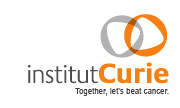Human Tumour DataBase
- Institut Curie Bioinformatics Unit: Séverine Lair, Philippe La Rosa and Emmanuel Barillot.
- Institut Curie, UMR 144 CNRS: Jean Paul Thiery and François Radvanyi.
- Institut Curie, U509 INSERM: Dr. Olivier Delattre, Alain Aurias, Marc-Henri Stern, Dr. Sarah Fattet.
- Institut Curie, Département de Biologie des tumeurs: Dr. Xavier Sastre-Garau, Dr. Anne Vincent-Salomon, Dr. Christophe Rosty.
- Institut Curie, Département Pédiatrie: Dr. Gudrun Schleiermacher.
- Institut Curie, Département Radiothérapie: Dr. Marc Bollet.
- Institut Curie, Département Médecine: Dr Sophie Piperno-Neumann.
- Institut Curie, Département Biostatistique: Dr Bernard Asselain.
Microarray studies, through the application of genetic and molecular biology information, have allowed biologists to study global gene expression in cells and tissues, to discover key players in metabolic pathways and to assign probable function to genes. The Institut Curie has a mission of treatment and research against cancer and a focus on several cancers including breast carcinomas, uveal melanoma, pediatric tumours and sarcomas.
Therefore, a data management tool has been created in the Research Center of Institut Curie: HuTuDB (Human Tumour DataBase). HuTuDB is composed of two parts: one to manage clinical patient information and the other to manage mainly transcriptomic data.
HuTuDB-clinical part- has been created to centralize, in anonymous way, relevant patient information. This information is used to perform genome and transcriptome analysis; the final goals are to obtain better understanding of oncogenesis mechanisms, to categorize homogeneous tumour group on a molecular level basis, to discover biomarkers or gene predictors for prognosis and diagnosis, and to discover new therapeutical targets.
The patient information stored in HuTuDB are centered on samples that are eligible for genome and transcriptome analysis (sufficient tumour content, RNA and DNA quality, good patient follow-up).
HuTuDB is accessible through a protected and user-friendly interface. Authorized person may consult, query and update (restricted access) the database and a direct access is offered to other softwares created at the Institut Curie.
The HuTuDB project is a close collaboration between the Hospital and Research Center of the Institut Curie.
HuTuDB-transcriptome part- allows users to:
- organize experimental data into a project and then define access rights,
- describe their data in a MIAME-compliant way (sample, RNA extraction, labelled-extract, experiment descriptions),
- store original (raw or normalized) data files,
- store and update annotations of features/reporters hybridized on microarray plateforms,
- use directly the Transcriptome Analysis Pipeline (TrAP),
- trace the history of performed analyses,
- download original data and results.
Different microarray platforms are accepted: Affymetrix GeneChips (with CEL files), glass slides (with gpr file (Genepix) or TrAP file format).
Normalized data are also accepted (with TrAP file format).
HuTuDB was initiated by Séverine Lair, Jean-Paul Thiery and François Radvanyi at Institut Curie, CNRS UMR 144. Since 2003 it is developed and managed by the Bioinformatics Unit of the Institut Curie. The technologies used in this project are Oracle RDBMS, Apache and PHP/HTML/Javascript.
